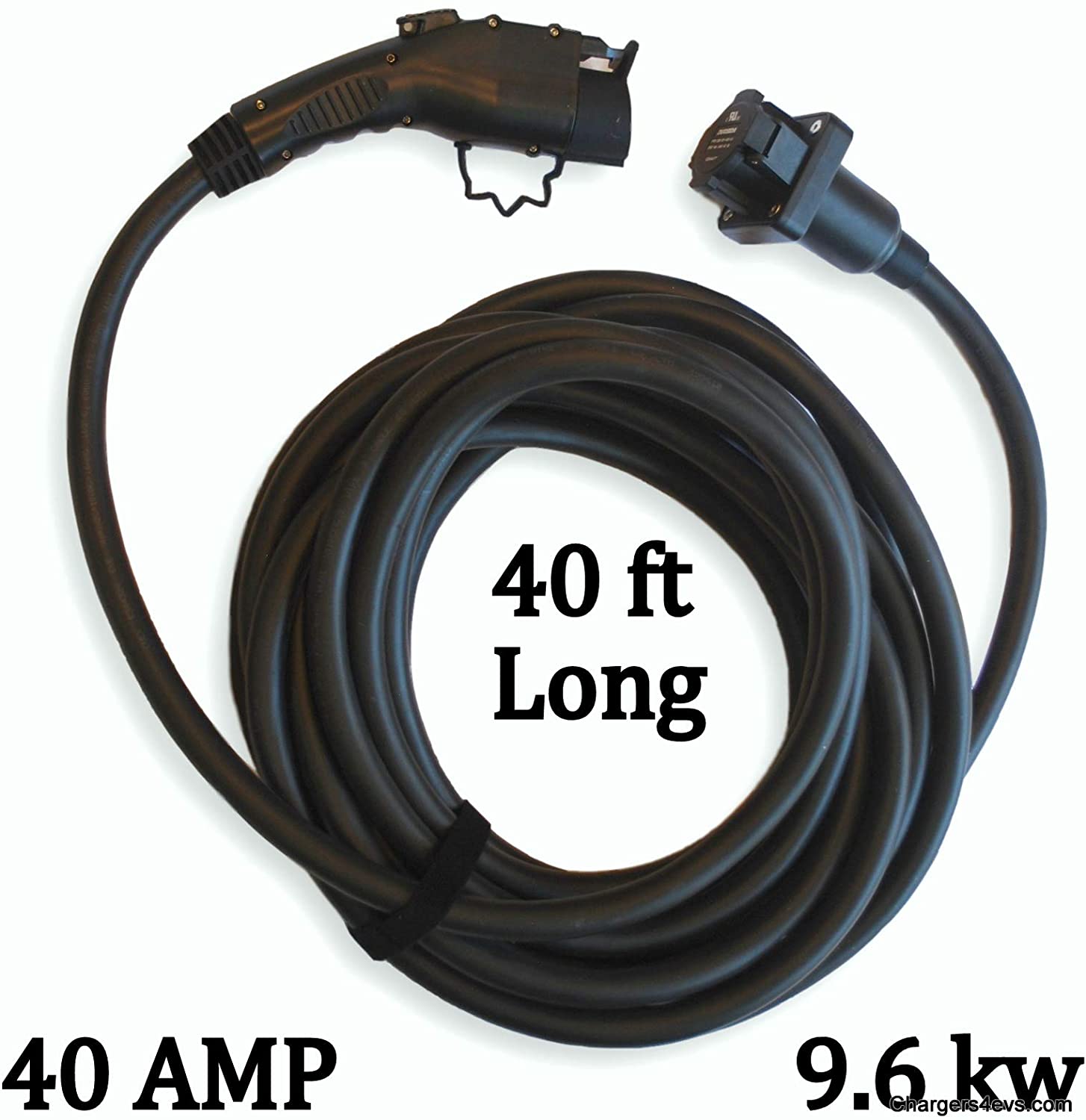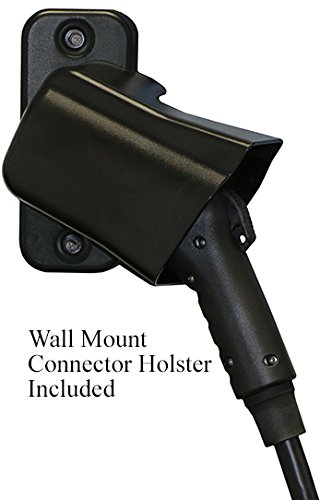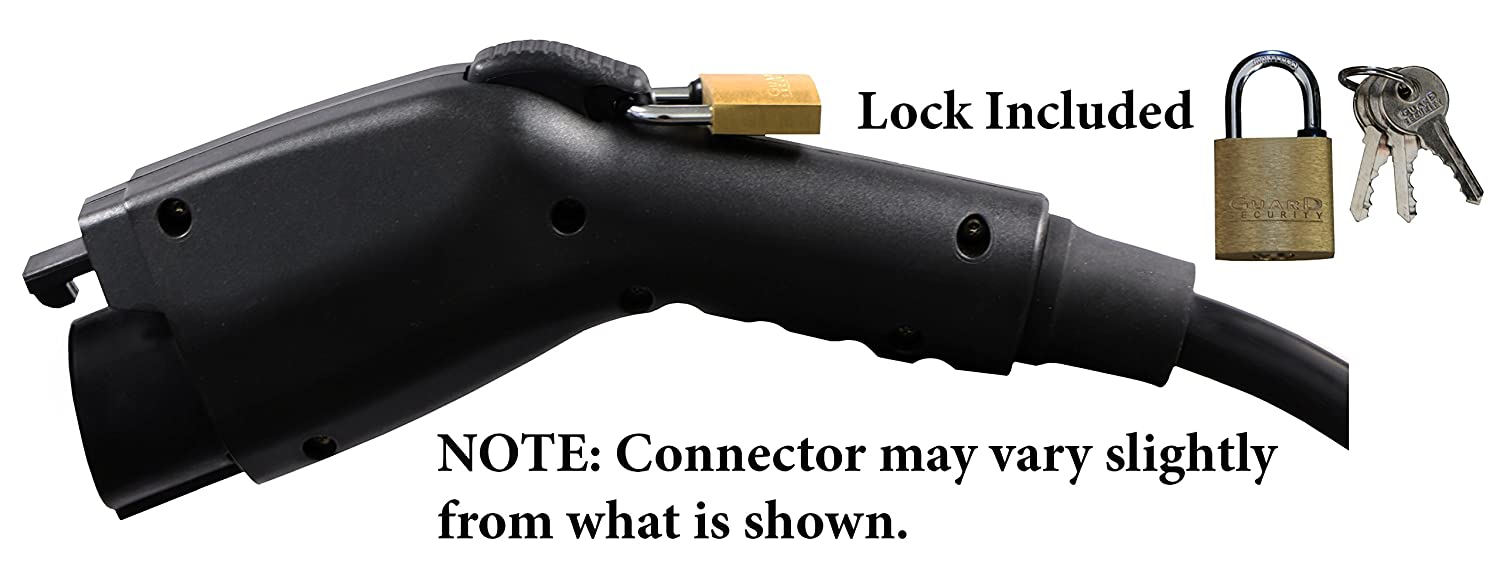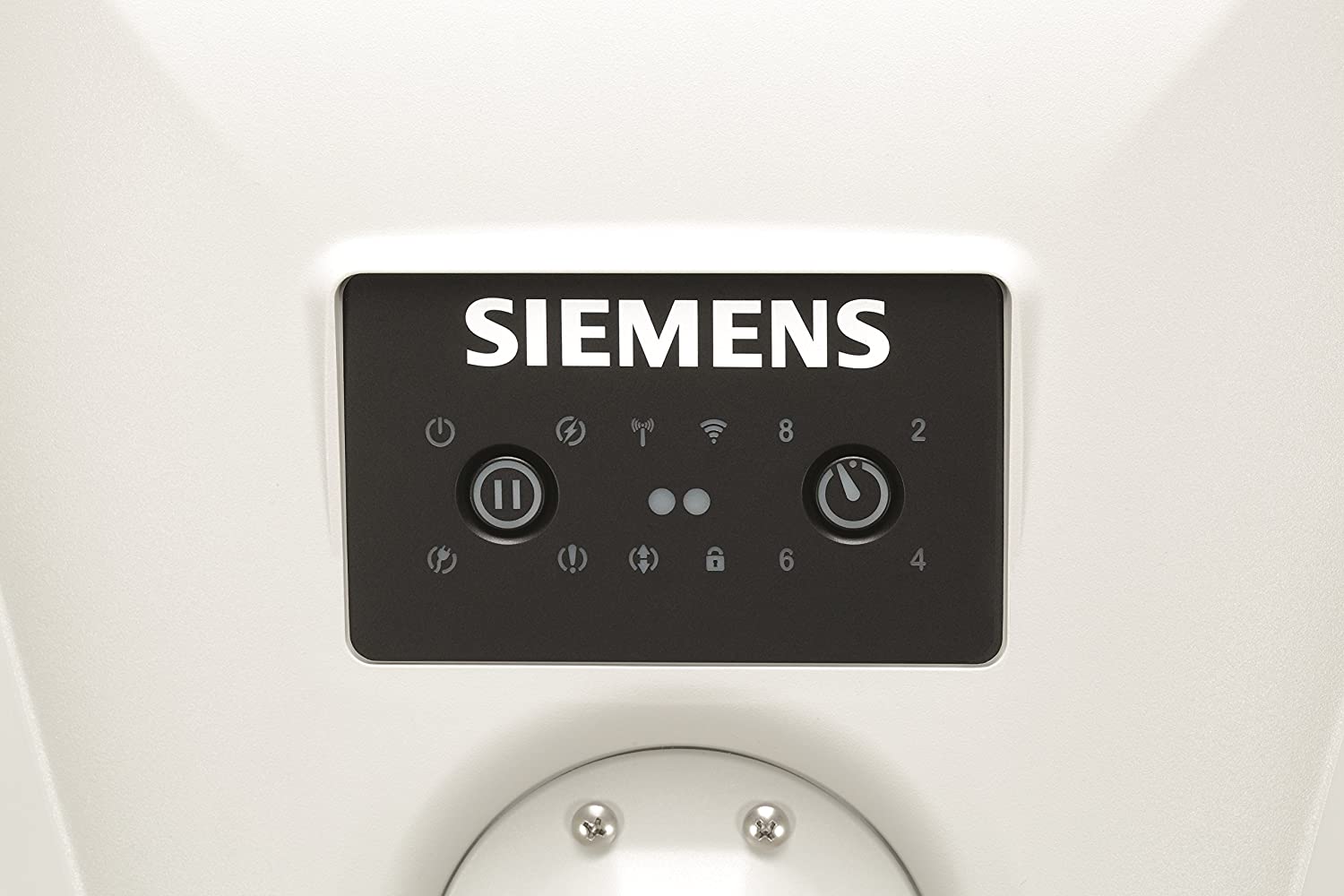Last Update: 2021-07-28T02:25:30.309Z
In the previous section we went over installing a charging station at home. Let's now look at the lowest cost (cheapest) ways to charge your electric car at home.
Electric Vehicle home charging station
As we'll see, the cost for a home charging station runs anywhere from "free" to over $2000 depending on what you're looking for. The tradeoff is primarily charging speed versus cost versus a station with "smart" features.
While electric vehicles charge with electricity, they do not have a regular power outlet. Because the automotive industry decided to use a special purpose charging port, a special-purpose charging plug is required. I used to think this was a conspiracy to keep us from using whatever power outlet is available. In truth it has to do with safety, since the charging port has interlocks preventing the vehicle from driving while it is charging and eliminating the risk of rain.

At the same time we don't have to go broke getting the ultimate charging station.
Generally speaking what's required is:
- A power outlet of sufficient power,
- Associated circuit breaker, and
- An EVSE (Electric Vehicle Service Equipment)
Charging rate and refueling time
The faster the charging rate the more quickly your car refuels. Generally speaking at 120 volts 12 amps an electric car gains 4-5 miles range per hour of charging, at 240 volts 16 amps the rate increases to 11 miles range per hour of charging, and at 240 volts 32 amps the rate increases to 20-25 miles range per hour of charging.
You need to understand the charging rate you honestly need. On your typical day how many miles do you drive? That will give you a ballpark figure for the required charging rate. A person whose daily commute is under 10 miles, can easily put off charging for 3 or 4 days, then charge overnight at 120 volts 12 amps. That is, 8 miles per day for 4 days is 32 miles, requiring 8 hours to recharge on 120 volts. Others drive 50 or 60 miles a day, and therefore need a full recharge every day, and a faster 6 kiloWatt charge rate means their car is fully refueled at all times. On the other hand, the person driving 50 miles a day can (barely) gain that much range overnight on a 120 volt charging station (13 hours).
In other words, as we pointed out elsewhere (What electric car charging rate do we need at home, at the office, on road trips, at airports, or elsewhere?), most people do not need a 6 kiloWatt charging station at home. Therefore, why pay extra for a higher power charging station? Of course there will be times when a faster recharge at home is desired. Even the person with 10 miles daily driving needs has those days requiring 200 miles in a day. Maybe spending some extra $$'s to get faster charging at home will be worthwhile?
Consider a hybrid solution:
- Low speed home charging with a cheap charging station
- Rely on public charging to handle days requiring more range
If you rarely need faster charging, why pay extra? Bottom line, though, it's your choice whether to buy the faster charging station or not.
Safety
The J1772 charging specification includes many built-in safety features making it very difficult to cause an electrical fire while charging an electric car. But, they still occasionally happen and it's best to make sure we don't get on the evening news for having done so.
The typical idea for cheapest home charging is the 120 volt charger that came with the car. If that charger doesn't reach, you might think it's okay to use a regular extension cord to close the gap. Before you do that please stop and read Safely use Extension Cords when charging an electric car or electric motorcycle
The short version of that story is - be careful and you'll be okay. That means a weather protected, GFCI protected, good quality power outlet, along with a 10 gauge heavy duty extension cord. That dodgy old power outlet that sparks every time you use it? Don't bring your charging station anywhere near it unless you want to lose your house.
Power outlet of sufficient power
We went over this in the previous section but it is worth repeating. The 80% rule in the electrical code requires that continuous loads (like electric car charging) run at 80% the rated capacity of the power outlet and circuit breaker. For example, the NEMA 14-50 outlet is rated for 50 amps, but a continuous load must be kept to 40 amps (80% of 50 amps). See Electric car charging within electrical code and power outlet limits
For the 120 volt line charger, you should get a good quality NEMA 5-20 outlet. The next smaller choice, NEMA 5-15, is too small for the 12 amp continuous load, while the 5-20 is way more than sufficient.
General outline
It's preferable to wire the charging station with a plug and install a matching power outlet. If the outlet is outdoors, give it a weatherproof cover. Make sure the wiring is capable of the continuous load. This combination gives you the option to take the charging station on trips. The electrical permit process might be simpler because it's just installing a power outlet.
Use the information below to guide how powerful a charging station to get. In reality most of us don't need the higher power charging stations at home. It's undeniable, however, that the higher charging rate is more convenient.
Free electric car charging at home
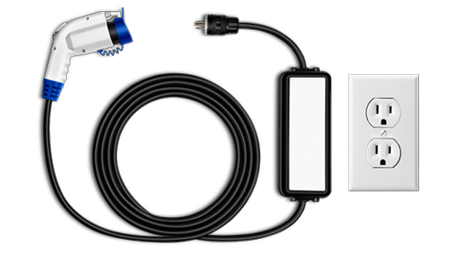
I promised to talk about a "free" solution, so here goes.
Every electric car comes with a "line cord charger" that -- in the U.S. -- runs at 120 volts 12 amps. That's simple then, just use that charging cord and you can recharge at home.
CONSIDERATION: This gives 4-5 miles of range per hour of charging. Is this sufficient for your real needs?
CONSIDERATION: You'll need a power outlet near where your vehicle sits. That power outlet needs GFCI protection so the circuit trips in case there's a problem.
CONSIDERATION: The manufacturers all say do not use an extension cord with the charging station. With care you can ignore that recommendation, as long as you pay attention to safety. See Safely use Extension Cords when charging an electric car or electric motorcycle for discussion of extension cords for electric car charging.
240 volt 16 amp charging at home
This bumps the charging rate to about 3 kiloWatts and the range gained to 11 miles per hour of charging. Some electric cars are limited to 3 kiloWatts anyway, such as the Chevy Volt.
At 11 miles per hour versus 4-5 miles, your home charging will be that much more useful. An overnight charging session can completely refuel the 80-100 mile range electric cars, for example.
This will require an electrical circuit rated for 240 volts 20 amps, of course.

 ClipperCreek LCS-20P, 240V,16A, EV Charging Station, with 14-50 plug, 25 ft cable
ClipperCreek LCS-20P, 240V,16A, EV Charging Station, with 14-50 plug, 25 ft cable
This charging station is very portable making it easy to use both at home and on the road. The 3 kiloWatt charging rate is an excellent choice for home charging, being 2-3 times faster than the charging speed at 120 volts. While away from home that charging speed may be too slow to be of practical use, but 3 kiloWatts is better than 0 kiloWatts or 1 kiloWatts. That it runs solely at 240 volts means it is less flexible than other compact EVSE's which support 120 volts. The LCS-20P comes fitted with a NEMA 14-50P Plug meaning that you'll need an adapter cord for any common 20 amp outlets like the NEMA 6-20. Clipper Creek is a highly recommended company with over a decade of experience building charging stations.
- Charge Rate: 16 amps - roughly 12 miles range per hour of charging
- Weight: 5 lbs
- 4 x 3 x 11 inches
240 volts 24 amps charging at home
Leviton makes a light-weight compact inexpensive charging station supporting 24 amp charging. It's attractive not just for home charging, but for traveling into areas where no public charging stations exist.
At this charging rate you're gaining perhaps 18-20 miles range per hour of charging. This is more useful than the 16 amp charging, while costing less (maybe) than 32 amp charging.
It will of course require a 30 amp circuit.

 Leviton EVBL2-P18 Level 2 Evr-Green Mini, Wall Mounted with Cord, 18'
Leviton EVBL2-P18 Level 2 Evr-Green Mini, Wall Mounted with Cord, 18'
The Evr-Green Mini is a highly portable charging station that's very useful both at home or on the road. Its size is about the same size as the typical line cord charger, but it supports a 5.7 kiloWatt (24 amp) charging rate. Between the small size and the useful power level, this is close to the perfect portable charging station. It comes with a NEMA 6-30 plug attached to the end of the cord, so make sure you get or build appropriate adapters.
- Charge Rate: 24 amps - roughly 18 miles range per hour of charging
- Weight: 2 lbs
- 20.9 x 3.2 x 1.8 inches
240 volts 32 amps charging at home
This matches the charging rate at most public charging stations, and the majority of electric cars max out at this charging rate. For the typical electric car, it gains 20-25 miles range per hour of charging. This may be overkill for home charging, it depends on your needs.
You will of course require a 40 amp circuit.
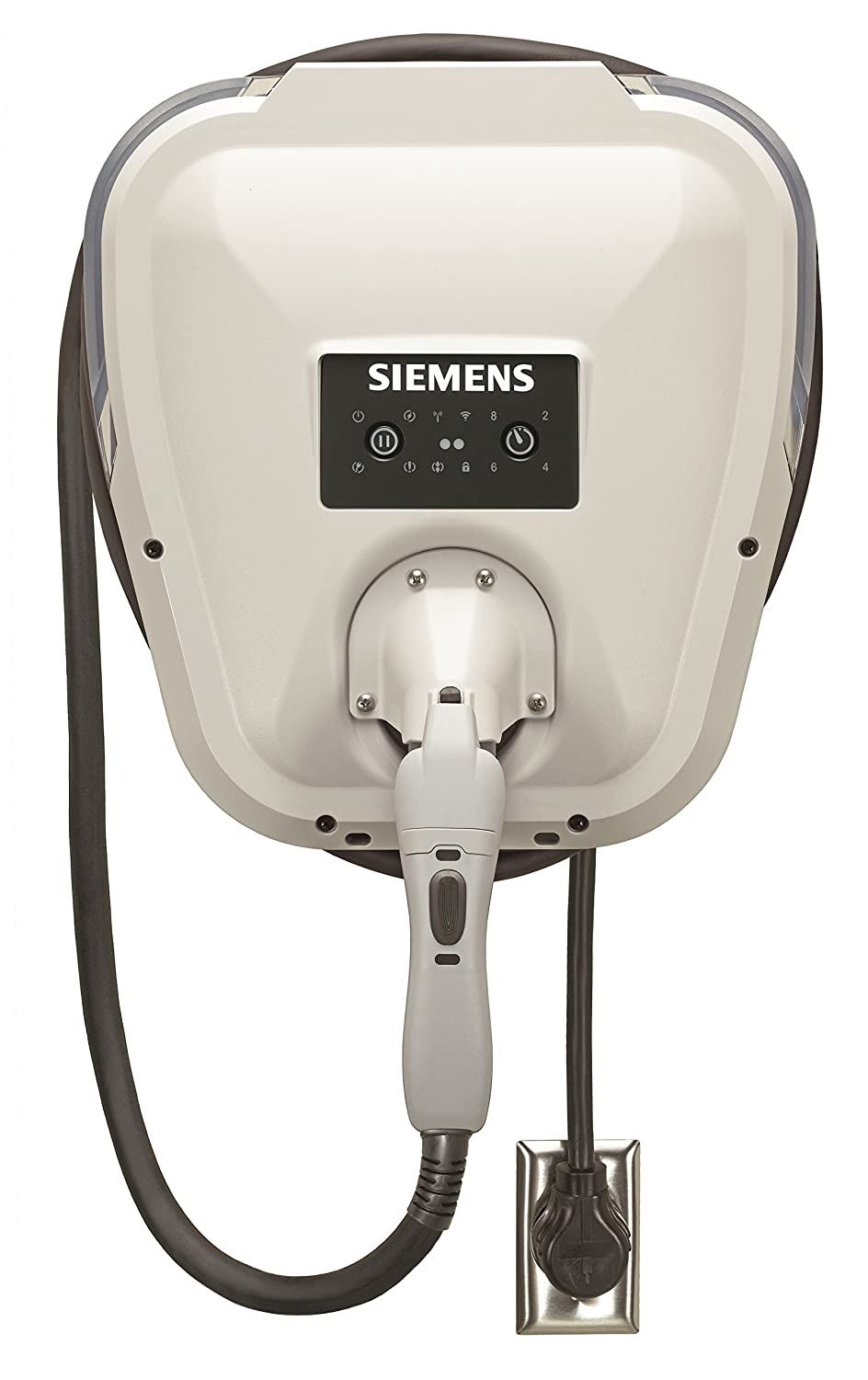
 Siemens VC30GRYU Versicharge 30-Amp Electric Vehicle Charger with Flexible Indoor/Outdoor and 20-Feet Cord
Siemens VC30GRYU Versicharge 30-Amp Electric Vehicle Charger with Flexible Indoor/Outdoor and 20-Feet Cord
This charging station is not portable, however it has an interesting set of features. It supports a maximum 30-32 amp charging rate, for a 3-4 hour recharge time on the 80 mile range electric vehicles. Unlike many of the charging stations, the Versicharge charge rate is adjustable allowing it to be installed on a lower power circuit. It can also be used with a Demand Response system allowing you to earn Demand Response revenue from certain electric utility companies. This version of the Siemens Versicharge comes pre-configured with a NEMA 6-50 plug, while another version must be hardwired.
- Charge Rate: 32 amps - roughly 20-25 miles range per hour of charging
- Weight: 18 lbs
- 16.5 x 16.5 x 6.5 inches
Installation costs for 20 amp, 30 amp, 40 amp, etc outlet
At the top we said Power outlet of sufficient power and then detailed several charging station choices at a 16 amps, 24 amps, and 32 amps charging rate. The process is largely the same for each - there's the cost to install the power outlet, and the cost for any city electrical permits. What does it cost?
There are many factors to consider. Wire is not cheap, and the further the outlet is from the service panel the more it will cost. Some cities require permits before electrical work is performed, and an inspection before the circuit can be energized.
The basic parts are about US$50 and can be bought in regular hardware stores.
The city permit might be US$100-200, depending on the city.
The installation job is a couple hours, so figure US$100-200 for labor.
If the task requires a service panel upgrade, or a new subpanel, or a long wiring run, or any of a number of other complications, the job can get expensive.
A key consideration - simply tell the electrician you want a NEMA 14-50 outlet, with matching 50 amp circuit breaker. They might get gleaming dollar signs in their eyes if you say anything more.
Higher power charging at home
Some electric cars support even higher charging rates, like 40 amps. Tesla Motors sells charging equipment supporting up to 80 amps charging. That's the opposite end of the scale from the earlier suggestion that 120 volt charging at home is sufficient for most people. Those owning longer range cars will think a 3 or 4 day recharge time at 120 volts is ridiculous, with good reason.
As longer range electric cars become the norm we may see more and more people with 80 amp charging at home. However, there are many homes whose total electric service is 80 amps.
The circuit capacity required is 1.25 times the continuous load. A 40 amp charging station requires a 50 amp circuit, and an 80 amp station requires a 100 amp circuit.

